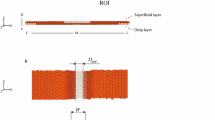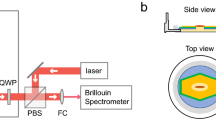Abstract
In the early embryo, the eyes form initially as relatively spherical optic vesicles (OVs) that protrude from both sides of the brain tube. Each OV grows until it contacts and adheres to the overlying surface ectoderm (SE) via an extracellular matrix (ECM) that is secreted by the SE and OV. The OV and SE then thicken and bend inward (invaginate) to create the optic cup (OC) and lens vesicle, respectively. While constriction of cell apices likely plays a role in SE invagination, the mechanisms that drive OV invagination are poorly understood. Here, we used experiments and computational modeling to explore the hypothesis that the ECM locally constrains the growing OV, forcing it to invaginate. In chick embryos, we examined the need for the ECM by (1) removing SE at different developmental stages and (2) exposing the embryo to collagenase. At relatively early stages of invagination (Hamburger–Hamilton stage HH14\(-\)), removing the SE caused the curvature of the OV to reverse as it ‘popped out’ and became convex, but the OV remained concave at later stages (HH15) and invaginated further during subsequent culture. Disrupting the ECM had a similar effect, with the OV popping out at early to mid-stages of invagination (HH14\(-\) to HH14\(+\)). These results suggest that the ECM is required for the early stages but not the late stages of OV invagination. Microindentation tests indicate that the matrix is considerably stiffer than the cellular OV, and a finite-element model consisting of a growing spherical OV attached to a relatively stiff layer of ECM reproduced the observed behavior, as well as measured temporal changes in OV curvature, wall thickness, and invagination depth reasonably well. Results from our study also suggest that the OV grows relatively uniformly, while the ECM is stiffer toward the center of the optic vesicle. These results are consistent with our matrix-constraint hypothesis, providing new insight into the mechanics of OC (early retina) morphogenesis.










Similar content being viewed by others
Notes
For simplicity, since our model does not include tissue remodeling, which occurs in vivo to partially maintain the relatively thicker OV after ECM degradation, the indentation tests were simulated for the OV in its initial state. As a check, we also ran these simulations for a partially invaginated OV with and without ECM. Although the computed stiffnesses were lower, the value of \(\bar{\mu }\) for the intact OV is approximately the same.
Notably, the extensional stiffness of the ECM is most important for constraining cellular expansion in the OV, rather than the bending stiffness. The matrix does not need to be stiffer than the cells to cause a flat epithelium to bend. However, for a spherical shell the curvature stiffens the structure and complicates the mechanics. According to our model, a relatively large ECM stiffness is required to force a reversal of curvature (see Fig. S4).
Natural variations in ECM and OV geometry or material properties could account for the different behaviors of some OVs at intermediate stages of invagination, especially near the critical invagination depth, which is especially sensitive to imperfections.
References
Adler R, Canto-Soler MV (2007) Molecular mechanisms of optic vesicle development: complexities, ambiguities and controversies. Dev Biol 305(1):1–13
Blatz PJ, Ko WL (1962) Application of finite elastic theory to the deformation of rubbery materials. Trans Soc Rheol 6(1):223–251
Borges RM, Lamers ML, Forti FL, Santos MFd, Yan CYI (2011) Rho signaling pathway and apical constriction in the early lens placode. Genesis 49(5):368–379
Božanić D, Saraga-Babić M (2004) Cell proliferation during the early stages of human eye development. Anat Embryol 208(5):381–388
Brady RC, Hilfer SR (1982) Optic cup formation: a calcium-regulated process. Proc Natl Acad Sci 79(18):5587–5591
Chauhan BK, Disanza A, Choi SY, Faber SC, Lou M, Beggs HE, Scita G, Zheng Y, Lang RA (2009) Cdc42-and IRSp53-dependent contractile filopodia tether presumptive lens and retina to coordinate epithelial invagination. Development 136(21):3657–3667
Daley WP, Yamada KM (2013) Ecm-modulated cellular dynamics as a driving force for tissue morphogenesis. Curr Opin Genet Dev 23(4):408–414
Davidson LA, Koehl M, Keller R, Oster GF (1995) How do sea urchins invaginate? Using biomechanics to distinguish between mechanisms of primary invagination. Development 121(7):2005–2018
Davidson L, Oster G, Keller R, Koehl M (1999) Measurements of mechanical properties of the blastula wall reveal which hypothesized mechanisms of primary invagination are physically plausible in the sea urchin strongylocentrotus purpuratus. Dev Biol 209(2):221–238
Eiraku M, Takata N, Ishibashi H, Kawada M, Sakakura E, Okuda S, Sekiguchi K, Adachi T, Sasai Y (2011) Self-organizing optic-cup morphogenesis in three-dimensional culture. Nature 472(7341):51–56
Eiraku M, Adachi T, Sasai Y (2012) Relaxation–expansion model for self-driven retinal morphogenesis. Bioessays 34(1):17–25
Fuhrmann S (2010) Eye morphogenesis and patterning of the optic vesicle. Curr Top Dev Biol 93:61
Grobstein C, Cohen J (1965) Collagenase: effect on the morphogenesis of embryonic salivary epithelium in vitro. Science 150(3696):626–628
Hamburger V, Hamilton HL (1951) A series of normal stages in the development of the chick embryo. J Morphol 88(1):49–92
Hendrix R, Zwaan J (1974) Changes in the glycoprotein concentration of the extracellular matrix between lens and optic vesicle associated with early lens differentiation. Differentiation 2(6):357–362
Hendrix RW, Zwaan J (1975) The matrix of the optic vesicle-presumptive lens interface during induction of the lens in the chicken embryo. J Embryol Exp Morphol 33(4):1023–1049
Hilfer SR, Randolph GJ (1993) Immunolocalization of basal lamina components during development of chick otic and optic primordia. Anat Rec 235(3):443–452
Hosseini HS, Beebe DC, Taber LA (2014) Mechanical effects of the surface ectoderm on optic vesicle morphogenesis in the chick embryo. J Biomech 47(16):3837–3846
Huang J, Rajagopal R, Liu Y, Dattilo LK, Shaham O, Ashery-Padan R, Beebe DC (2011) The mechanism of lens placode formation: a case of matrix-mediated morphogenesis. Dev Biol 355(1):32–42
Hyer J, Kuhlman J, Afif E, Mikawa T (2003) Optic cup morphogenesis requires pre-lens ectoderm but not lens differentiation. Dev Biol 259(2):351–363
Jidigam VK, Gunhaga L (2013) Development of cranial placodes: insights from studies in chick. Dev Growth Differ 55(1):79–95
Kakou A, Bézie Y, Mercier N, Louis H, Labat C, Challande P, Lacolley P, Safar ME (2009) Selective reduction of central pulse pressure under angiotensin blockage in SHR: role of the fibronectin-\(\alpha 5\beta 1\) integrin complex. Am J Hypertens 22(7):711–717
Kwan KM (2014) Coming into focus: the role of extracellular matrix in vertebrate optic cup morphogenesis. Dev Dyn 243(10):1242–1248
Lane MC, Koehl M, Wilt F, Keller R (1993) A role for regulated secretion of apical extracellular matrix during epithelial invagination in the sea urchin. Development 117(3):1049–1060
Li Z, Joseph NM, Easter SS (2000) The morphogenesis of the zebrafish eye, including a fate map of the optic vesicle. Dev Dyn 218(1):175–188
Martinez-Morales JR, Wittbrodt J (2009) Shaping the vertebrate eye. Curr Opin Genet Dev 19(5):511–517
Mic FA, Molotkov A, Molotkova N, Duester G (2004) Raldh2 expression in optic vesicle generates a retinoic acid signal needed for invagination of retina during optic cup formation. Dev Dyn 231(2):270–277
Nakano T, Ando S, Takata N, Kawada M, Muguruma K, Sekiguchi K, Saito K, Yonemura S, Eiraku M, Sasai Y (2012) Self-formation of optic cups and storable stratified neural retina from human escs. Cell Stem Cell 10(6):771–785
Norden C, Young S, Link BA, Harris WA (2009) Actomyosin is the main driver of interkinetic nuclear migration in the retina. Cell 138(6):1195–1208
Oberhauser AF, Badilla-Fernandez C, Carrion-Vazquez M, Fernandez JM (2002) The mechanical hierarchies of fibronectin observed with single-molecule afm. J Mol Biol 319(2):433–447
Plageman TF, Chauhan BK, Yang C, Jaudon F, Shang X, Zheng Y, Lou M, Debant A, Hildebrand JD, Lang RA (2011) A Trio-Rhoa-Shroom3 pathway is required for apical constriction and epithelial invagination. Development 138(23):5177–5188
Ramasubramanian A, Taber LA (2008) Computational modeling of morphogenesis regulated by mechanical feedback. Biomech Model Mechanobiol 7(2):77–91
Rifes P, Thorsteinsdóttir S (2012) Extracellular matrix assembly and 3d organization during paraxial mesoderm development in the chick embryo. Dev Biol 368(2):370–381
Rodriguez EK, Hoger A, McCulloch AD (1994) Stress-dependent finite growth in soft elastic tissues. J Biomech 27(4):455–467
Sasai Y, Eiraku M, Suga H (2012) In vitro organogenesis in three dimensions: self-organising stem cells. Development 139(22):4111–4121
Slavotinek AM (2011) Eye development genes and known syndromes. Mol Genet Metab 104(4):448–456
Smith AN, Miller LAD, Song N, Taketo MM, Lang RA (2005) The duality of \(\beta \)-catenin function: a requirement in lens morphogenesis and signaling suppression of lens fate in periocular ectoderm. Dev Biol 285(2):477–489
Spemann H (1901) Über Korrelationen in der Entwicklung des Auges. Verh Anat Ges 15:61–79
Taber LA (2004) Nonlinear theory of elasticity: applications in biomechanics. World Scientific, New Jersey
Taber LA (2014) Morphomechanics: transforming tubes into organs. Curr Opin Genet Dev 27:7–13
Tsukiji N, Nishihara D, Yajima I, Takeda K, Shibahara S, Yamamoto H (2009) Mitf functions as an in ovo regulator for cell differentiation and proliferation during development of the chick RPE. Dev Biol 326(2):335–346
Van Essen DC, Drury HA, Dickson J, Harwell J, Hanlon D, Anderson CH (2001) An integrated software suite for surface-based analyses of cerebral cortex. J Am Med Inf Assoc 8(5):443–459
Voronov DA, Taber LA (2002) Cardiac looping in experimental conditions: effects of extraembryonic forces. Dev Dyn 224(4):413–421
Webster EH, Silver AF, Gonsalves NI (1983) Histochemical analysis of extracellular matrix material in embryonic mouse lens morphogenesis. Dev Biol 100(1):147–157
Webster EH, Silver AF, Gonsalves NI (1984) The extracellular matrix between the optic vesicle and presumptive lens during lens morphogenesis in an anophthalmic strain of mice. Dev Biol 103(1):142–150
Wessells NK, Cohen JH (1968) Effects of collagenase on developing epithelia in vitro: lung, ureteric bud, and pancreas. Dev Biol 18(3):294–309
Wride MA (1996) Cellular and molecular features of lens differentiation: a review of recent advances. Differentiation 61(2):77–93
Xu G, Kemp PS, Hwu JA, Beagley AM, Bayly PV, Taber LA (2010) Opening angles and material properties of the early embryonic chick brain. J Biomech Eng 132(1):011,005
Yang Y, Niswander L (1995) Interaction between the signaling molecules WNT7a and SHH during vertebrate limb development: dorsal signals regulate anteroposterior patterning. Cell 80(6):939–947
Zamir EA, Srinivasan V, Perucchio R, Taber LA (2003) Mechanical asymmetry in the embryonic chick heart during looping. Ann Biomed Eng 31(11):1327–1336
Zolessi FR, Arruti C (2001) Apical accumulation of marcks in neural plate cells during neurulation in the chick embryo. BMC Dev Biol 1(1):7
Zwaan J, Hendrix RW (1973) Changes in cell and organ shape during early development of the ocular lens. Am Zool 13(4):1039–1049
Zwaan J, Bryan PR, Pearce TL et al (1969) Interkinetic nuclear migration during the early stages of lens formation in the chicken embryo. J Embryol Exp Morphol 21(1):71–83
Acknowledgments
We are grateful to Philip Bayly, Ruth Okamoto, Kristen Naegle, and members of the LAT laboratory for helpful discussions. We thank the Department of Mechanical Engineering and Materials Science for use of the confocal microscope. This work was supported by NIH Grant R01 NS070918 (LAT) and a fellowship for AO through the Imaging Sciences Pathway at Washington University (NIH T32 EB014855).
Author information
Authors and Affiliations
Corresponding author
Additional information
D. C. Beebe: Deceased April 2015.
Electronic supplementary material
Below is the link to the electronic supplementary material.
Supplementary material 2 (avi 7601 KB)
Supplementary material 3 (avi 9106 KB)
Supplementary material 4 (avi 8584 KB)
Rights and permissions
About this article
Cite this article
Oltean, A., Huang, J., Beebe, D.C. et al. Tissue growth constrained by extracellular matrix drives invagination during optic cup morphogenesis. Biomech Model Mechanobiol 15, 1405–1421 (2016). https://doi.org/10.1007/s10237-016-0771-8
Received:
Accepted:
Published:
Issue Date:
DOI: https://doi.org/10.1007/s10237-016-0771-8




